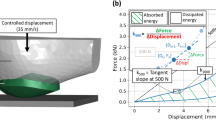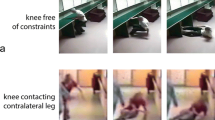Abstract
Hip fracture incidence rates are influenced by body mass index (BMI) and sex, likely through mechanistic pathways that influence dynamics of the pelvis-femur system during fall-related impacts. The goal of this study was to extend our understanding of these impact dynamics by investigating the effects of BMI, sex, and local muscle activation on pressure distribution over the hip region during lateral impacts. Twenty participants underwent “pelvis-release experiments” (which simulate a lateral fall onto the hip), including muscle-‘relaxed’ and ‘contracted’ trials. Males and low-BMI individuals exhibited 44 and 55% greater peak pressure, as well as 66 and 56% lower peripheral hip force, compared to females and high-BMI individuals, respectively. Local muscle activation increased peak force by 10%, contact area by 17%, and peripheral hip force by 11% compared to relaxed trials. In summary, males and low-BMI individuals exhibited more concentrated loading over the greater trochanter. Muscle activation increased peak force, but this force was distributed over a larger area, preventing increased localized loading over the greater trochanter. These findings suggest potential value in incorporating sex, gender, and muscle activation-specific force distributions as inputs into computational tissue-level models, and have implications for the design of personalized protective devices including wearable hip protectors.






Similar content being viewed by others
Abbreviations
- BMI:
-
Body mass index
- GT:
-
Greater trochanter
- MVC:
-
Maximal voluntary contraction
- SENIAM:
-
Surface electromyography for non-invasive assessment of muscles
References
Armstrong, M. E., E. A. Spencer, B. J. Cairns, E. Banks, K. Pirie, J. Green, F. L. Wright, G. K. Reeves, and V. Beral. Body mass index and physical activity in relation to the incidence of hip fracture in postmenopausal women. J. Bone Miner. Res. 26:1330–1338, 2011.
Bhan, S., I. C. Levine, and A. C. Laing. Energy absorption during impact on the proximal femur is affected by body mass index and flooring surface. J. Biomech. 47:2391–2397, 2014.
Bjorgul, K., and O. Reikeras. Incidence of hip fracture in southeastern Norway: a study of 1730 cervical and trochanteric fractures. Int. Orthop. 31:665–669, 2007.
Bouxsein, M. L., P. Szulc, F. Munoz, E. Thrall, E. Sornay-Rendu, and P. D. Delmas. Contribution of trochanteric soft tissues to fall force estimates, the factor of risk, and prediction of hip fracture risk. J. Bone Miner. Res. 22:825–831, 2007.
Burkhart, T. A., and D. M. Andrews. Kinematics, kinetics and muscle activation patterns of the upper extremity during simulated forward falls. J. Electromyogr. Kinesiol. 23:688–695, 2013.
Chang, C. Y., J. D. Rupp, M. P. Reed, R. E. Hughes, and L. W. Schneider. Predicting the effects of muscle activation on knee, thigh, and hip injuries in frontal crashes using a finite-element model with muscle forces from subject testing and musculoskeletal modeling. Stapp Car Crash J. 53:291–328, 2009.
Chevalley, T., E. Guilley, F. R. Herrmann, P. Hoffmeyer, C. H. Rapin, and R. Rizzoli. Incidence of hip fracture over a 10-year period (1991–2000): reversal of a secular trend. Bone 40:1284–1289, 2007.
Choi, W. J., P. A. Cripton, and S. N. Robinovitch. Effects of hip abductor muscle forces and knee boundary conditions on femoral neck stresses during simulated falls. Osteoporosis Int. 26:291–301, 2014.
Choi, W. J., J. A. Hoffer, and S. N. Robinovitch. Effect of hip protectors, falling angle and body mass index on pressure distribution over the hip during simulated falls. Clin. Biomech. 25:63–69, 2010.
Cummings, S., and L. Melton. Epidemiology and outcomes of osteoporotic fractures. Lancet 359:1761–1767, 2002.
Feldman, F., and S. N. Robinovitch. Reducing hip fracture risk during sideways falls: evidence in young adults of the protective effects of impact to the hands and stepping. J. Biomech. 40:2612–2618, 2007.
Gilchrist, S., P. Guy, and P. A. Cripton. Development of an inertia-driven model of sideways fall for detailed study of femur fracture mechanics. J. Biomech. Eng. 135:121001–121008, 2013.
Grisso, J. A., J. L. Kelsey, B. L. Strom, G. Y. Chiu, G. Maislin, L. A. O’Brien, S. Hoffman, and F. Kaplan. Risk factors for falls as a cause of hip fracture in women. The Northeast Hip Fracture Study Group. N. Engl. J. Med. 324:1326–1331, 1991.
Hayes, W. C., E. R. Myers, S. N. Robinovitch, A. van den Kroonenberg, A. C. Courtney, and T. A. McMahon. Etiology and prevention of age-related hip fractures. Bone 18:S77–S86, 1996.
Kannegaard, P. N., S. van der Mark, P. Eiken, and B. Abrahamsen. Excess mortality in men compared with women following a hip fracture. National analysis of comedications, comorbidity and survival. Age Ageing 39:203–209, 2010.
Laing, A. C., and S. N. Robinovitch. Effect of soft shell hip protectors on pressure distribution to the hip during sideways falls. Osteoporosis Int. 19:1067–1075, 2008.
Laing, A. C., and S. N. Robinovitch. The force attenuation provided by hip protectors depends on impact velocity, pelvic size, and soft tissue stiffness. J. Biomech. Eng. 130:061005–061009, 2008.
Levine, I. C., S. Bhan, and A. C. Laing. The effects of body mass index and sex on impact force and effective pelvic stiffness during simulated lateral falls. Clin. Biomech. 28:1026–1033, 2013.
Levine, I. C., L. E. Minty, and A. C. Laing. Factors that influence soft tissue thickness over the greater trochanter: Application to understanding hip fractures. Clin. Anat. 28:253–261, 2015.
Ley, C. J., B. Lees, and J. Stevenson. Sex- and menopause-associated changes in body-fat distribution. Am. J. Clin. Nutr. 55:950–954, 1992.
Luo, Y. A biomechanical sorting of clinical risk factors affecting osteoporotic hip fracture. Osteoporosis Int. 27(423–439):2016, 2016.
Maitland, L. A., E. R. Myers, J. A. Hipp, W. C. Hayes, and S. L. Greenspan. Read my hips: measuring trochanteric soft tissue thickness. Calcif. Tissue Int. 52:85–89, 1993.
Majumder, S., A. Roychowdhury, and S. Pal. Simulation of hip fracture in sideways fall using a 3D finite element model of pelvis-femur-soft tissue complex with simplified representation of whole body. Med. Eng. Phys. 29:1167–1178, 2007.
Makhsous, M., F. Lin, A. Cichowski, I. Cheng, C. Fasanati, T. Grant, and R. W. Hendrix. Use of MRI images to measure tissue thickness over the ischial tuberosity at different hip flexion. Clin. Anat. 24:638–645, 2011.
Manske, S. L., T. Liu-Ambrose, P. M. De Bakker, D. Liu, S. Kontulainen, P. Guy, T. R. Oxland, and H. A. McKay. Femoral neck cortical geometry measured with magnetic resonance imaging is associated with proximal femur strength. Osteoporosis Int. 17:1539–1545, 2006.
Martel, D. R., I. C. Levine, S. P. Pretty, and A. C. Laing. The influence of muscle activation on impact dynamics during lateral falls on the hip. J. Biomech. 17:1, 2016.
Nasiri, M., and Y. Luo. Study of sex differences in the association between hip fracture risk and body parameters by DXA-based biomechanical modeling. Bone 90:90–98, 2016.
Newell, R. S., J. Blouin, J. Street, P. A. Cripton, and G. P. Siegmund. Neck posture and muscle activity are different when upside down: a human volunteer study. J. Biomech. 46:2837–2843, 2013.
Robinovitch, S. N., W. C. Hayes, and T. A. McMahon. Prediction of femoral impact forces in falls on the hip. J. Biomech. Eng. 113:366–374, 1991.
Robinovitch, S. N., T. A. McMahon, and W. C. Hayes. Force attenuation in trochanteric soft tissues during impact from a fall. J. Orthop. Res. 13:956–962, 1995.
Seniam. Surface ElectroMyoGraphy for Non-Invasive Assesment of Muscle (SENIAM). sfcd: wefscz, 2010.
Stolee, P., J. Poss, R. J. Cook, K. Byrne, and J. P. Hirdes. Risk factors for hip fracture in older home care clients. J. Gerontol. A Biol. Sci. Med. Sci. 64:403–410, 2009.
Acknowledgments
This research was funded in part by an operating grant from the Natural Sciences and Engineering Research Council of Canada (RGPIN-2015-03636), and infrastructure grants from the Canadian Foundation for Innovation (Grant # 25351) and the Ontario Ministry of Research and Innovation (Grant # 25351).
Conflict of interest
The authors have no conflicts of interest to declare. No persons other than the authors had input into any aspect of the study including research question development, study design, data analysis, interpretation of results, or manuscript writing.
Author information
Authors and Affiliations
Corresponding author
Additional information
Associate Editor Jane Grande-Allen oversaw the review of this article.
Rights and permissions
About this article
Cite this article
Pretty, S.P., Martel, D.R. & Laing, A.C. The Influence of Body Mass Index, Sex, & Muscle Activation on Pressure Distribution During Lateral Falls on the Hip. Ann Biomed Eng 45, 2775–2783 (2017). https://doi.org/10.1007/s10439-017-1928-z
Received:
Accepted:
Published:
Issue Date:
DOI: https://doi.org/10.1007/s10439-017-1928-z




